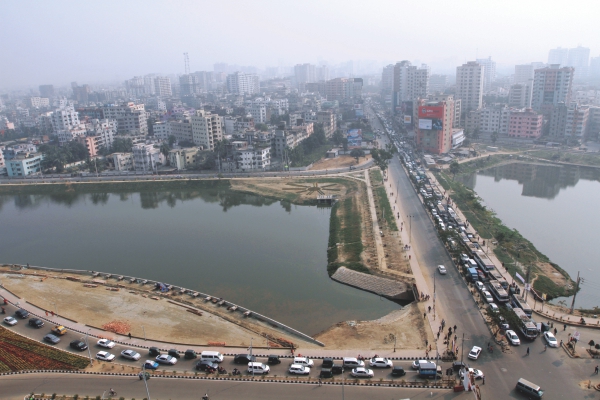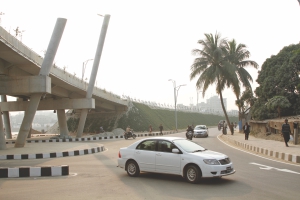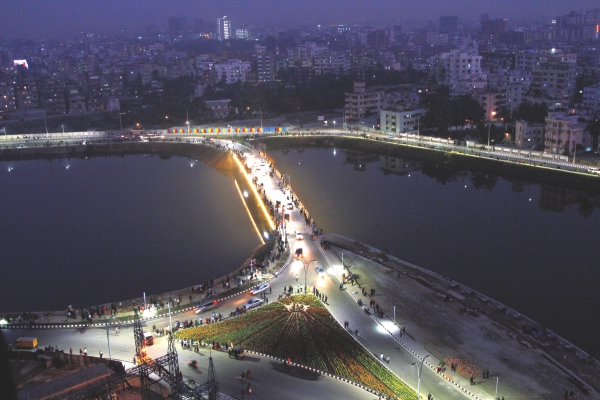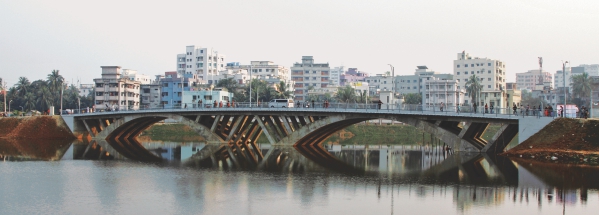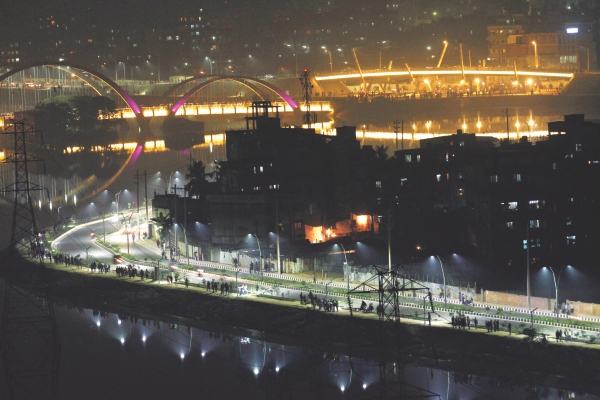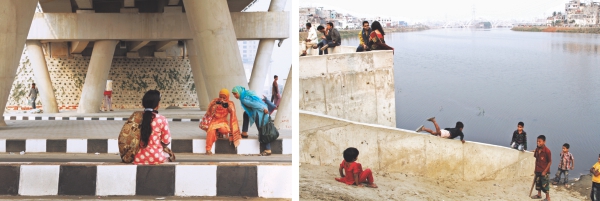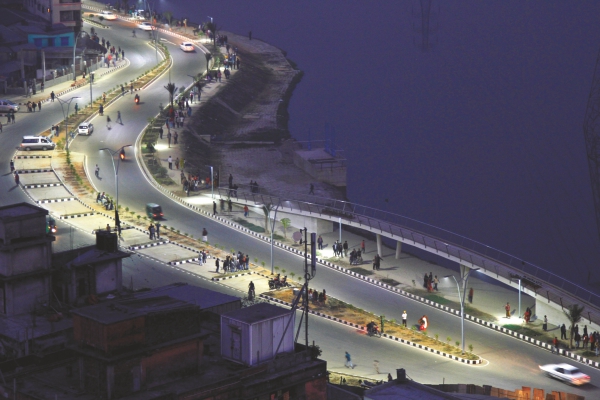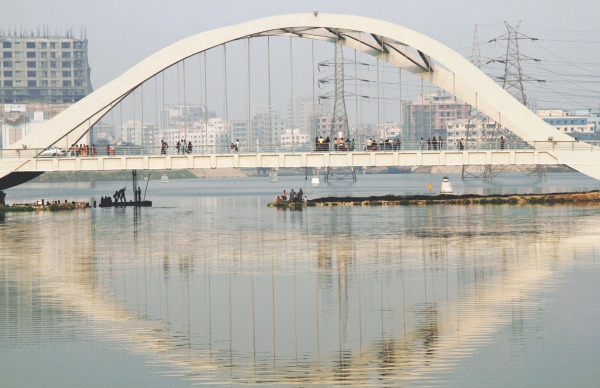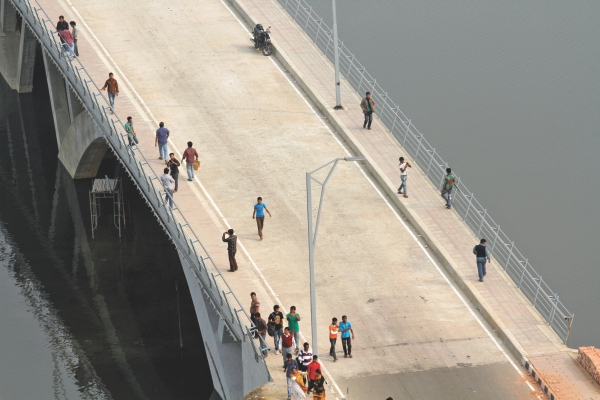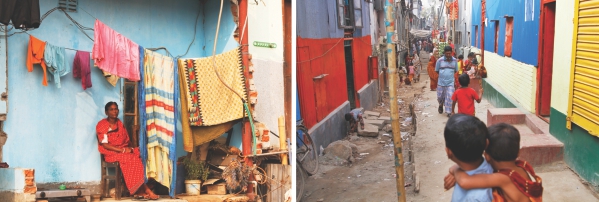| Home - Back Issues - The Team - Contact Us |
 |
| Volume 12 |Issue 02| January 11, 2013 | |
|
|
Cover Story
WHERE ELEPHANTS ONCE TREAD Zahir Hassan Nabil Photos: Amirul Rajiv
Word of mouth has it that in the 1800s, the Pilkhana was used for keeping the state-owned elephants and rented out to rich Zamindars for keeping their elephants. The elephants were walked via Elephant Road to Hatirjheel (which literally means 'elephant's canal') for bathing. They were driven under a bridge at the juncture of Elephant Road and Paribagh, hence the name Hatirpool ('elephant's bridge), according to the book Kingbodontir Dhaka by Nazir Hossain. Until only a few years ago the acrid stench yards away from the Hatirjheel and Begunbari canals would slingshot people as far away as they could get. Onrush from the sewerage used to pour into the dead canals, the texture of which was only comparable to the black waters of the Buriganga river. The dump yard was nonetheless home to numerous illegal establishments including corporate and commercial ones. Imagine the contrast between the Zamindars' elegant elephants being taken for a bath in Hatirjheel and a wasteland on which the land grabbers were pursued by the Rajuk in the last few years.
Things have changed quite drastically in the last two years. People from all walks of life swarmed to the lakeside following the inaugural ceremony of the Begunbari-Hatirjheel development scheme on January 2 and onwards. The Bailey bridge over the lake has already become a signature icon of the project. Vibrant flowerbeds were scattered over the landscapes; the canals had been dredged into deep lakes. Bricks were still being laid out here and there. Cameras were clicking away while people posed keeping the long expressways and the lake in the background, gusts would almost want to shove them off the bridge. Hundreds took the walkway starting from the Tejgaon side while some sat on the benches enjoying the lakeside view. It is only a matter of time till the carefully planted trees and feeble saplings grow into huge canopies to shade the walkways.
As dusk set, sturdy columns holding up the flyover and the bridge adorned with multi-coloured floodlights were floating like a glittery veneer on the lucent lake water. The well-lit roadways from a distance appeared as though illuminated lines had been furrowed up until the horizon. People had come with great anticipation to see how the ruins had become a sight for sore eyes. Some would not want to leave the lakesides up until 2 am the earlier night, an army official in charge of security informed. Leaning on the railing of the Bailey bridge over the lake, CA student Rafiul said, “I didn't know until the inauguration that the project was initiated during the caretaker government's tenure,” thanking everyone who made the project a success.
Around four years ago, Rajuk in association with Dhaka Water and Sewerage Authority (Wasa) and the Local Government Engineering Department (LGED), took up the project to recover the 304 acres of land and the city's largest water retention basin – Hatirjheel and Begunbari canals. Bangladesh University of Engineering and Technology (Buet) laid out the design while the 16 Engineering Construction Battalion (ECB) of the Bangladesh army took care of the construction. One 10 kilometre express road stretching from east to west, a similar length walkway along the lake accompanied by a nine-kilometre service road with footpath are notable public facilities. Four overpasses, a 260-metre viaduct and six bridges add to the well-planned commuting network that should lessen traffic jams in all adjoining areas, particularly Badda, Gulshan, Modhubagh, Moghbazar, Mouchak, Rampura, Tejgaon and Ulan.
Besides, once the Hatirjheel unites with the Gulshan lake, the first intracity waterway will kick off offering an uninterrupted ride from Baridhara to Tejgaon (FDC intersection at Tongi diversion road). The project's beautification and amusement facilities such as a celebration point, water court, floating walkway, viewing deck, children's play apparatus, water taxi terminal, lakeside landing steps, and amphitheatre are yet to shape up. These days, it is hard to figure out the real 'heart' of the city - thanks to the real estate developers in town for naming almost every part of the city as “the heart” in their advertisements. Located just in the midst of major city areas, Hatirjheel with its aesthetic architecture combined with the greenery sprouting up in the upcoming spring will become the heart of the city from every aspect. The junction of a couple of dead-ends of Tejgaon, Moghbazar, Rampura etc are now surely open to endless possibilities for realtors. A trip along the neighbourhood near the Tejgaon area reveals that the people are overwhelmingly relieved to have the once-poisoned Hatirjheel and Begunbari canals turned into breathing hearts. A pharma shop owner, requesting anonymity, refers to the return of discipline, law and order in the area. “People living close to the lake at Tejgaon and Moghbazar got rid of the thugs and hooligans who used the lakeside as a hangout for drugs; crime in the area has reduced significantly,” he says with satisfaction.
“All makeshift shanties on bamboo columns over the lake were cleared off as soon as the army took up the construction task", says a fish trader who visits the place every now and then as his son lives in the area. His wife sitting on a lakeside bench adds, "The local 'leaders' used to rent those out to slum dwellers.” Sharmin, a housewife from Gulshan I, came with her family to see for herself how the place turned into a breathing space from its unliveable condition for years. The walkways parallel to the canals, the wide, two-lane expressway seem the most benefitting aspects of the project to her. “Our travels to Banglamotor and Tejgaon areas will be cut short; I wish there were more initiatives like this,” she says.
Dhaka dwellers certainly look forward to several new projects that would sooth the city traffic. Just following the completion of the Banani overpass six days before the Hatirjheel inauguration, the flyover connecting Mirpur and Airport Road is expected to become functional in March this year. Construction work is underway for the 3.1 kilometre Kuril flyover at the Kuril intersection connecting Airport Road and Pragati Sarani, and the 10 kilometre Gulistan-Jatrabari flyover stretching between the Dhaka-Chittagong highway and Palashi. Over eight kilometres long, the Moghbazar – Mouchak flyover project will soon hit the road as well. Over the last few years quite a handful of buildings had to be bulldozed to resuscitate the canal-turned-lake that has been prepared with an objective to contain and drain out excessive water in the city. Yet the 15-storey BGMEA building remains an eyesore on the Tejgaon brink of the canal. Rajuk Chairman Nurul Huda informs over the phone, “The High Court order regarding elimination of the BGMEA building in early 2011 is still awaiting decision at the Supreme Court.” Moreover the development project has some 78 cases filed against various eviction drives, he says.
Quite contrary to the grandeur of the project, there is a gloomy, dark side too. It was as if a terrible misfortune had befallen on the slum dwellers and low-income people, many of whom were evicted from illegal establishments. Notably in September last year, around 400 shanties along the lake were reduced to ashes in a devastating fire. No casualties were reported in the incident that put about 2,000 slum dwellers into looming uncertainty. The tattered, somewhat unplanned and shabby look of the buildings, bazaars and slums in these areas now stand out in stark difference to the Hatirjheel development scheme. Both the lakesides were mainly occupied by low-income people who had been and will be affected the most by this project. It is a matter of great concern because in the last two years city house rent has reportedly increased by 26 percent whereas slum rent soared by almost 38 percent, according to Consumer Association of Bangladesh (CAB) statistics.
In mid-2009, the then state minister for Housing declared to erect high-rise buildings for the people affected by the project. It is fortunate that the prime minister at the project's inaugural ceremony this year duly readdressed the issue and instructed the housing ministry to rehabilitate all the affected people and make sure that a list of genuine sufferers is made quickly before opportunists try to take advantage of the offer. Keeping in mind the soaring house rent and various hassles of relocating thousands, it is almost imperative that the government carries out what it had promised. The projects' maintenance issues must be dealt with paramount importance to keep up such a brilliant urban development for the public. In praise of the effort in the project's opening, LGRD Minister Syed Ashraful Islam could not help but muse that the army may build the Padma Bridge. The making of the ambitious Hatirjheel project, that will sooth the city's burden in various ways, gives a lucid impression that things can still be turned around in the country with honest and disciplined efforts.
|
||
Copyright
(R) thedailystar.net 2013 |
